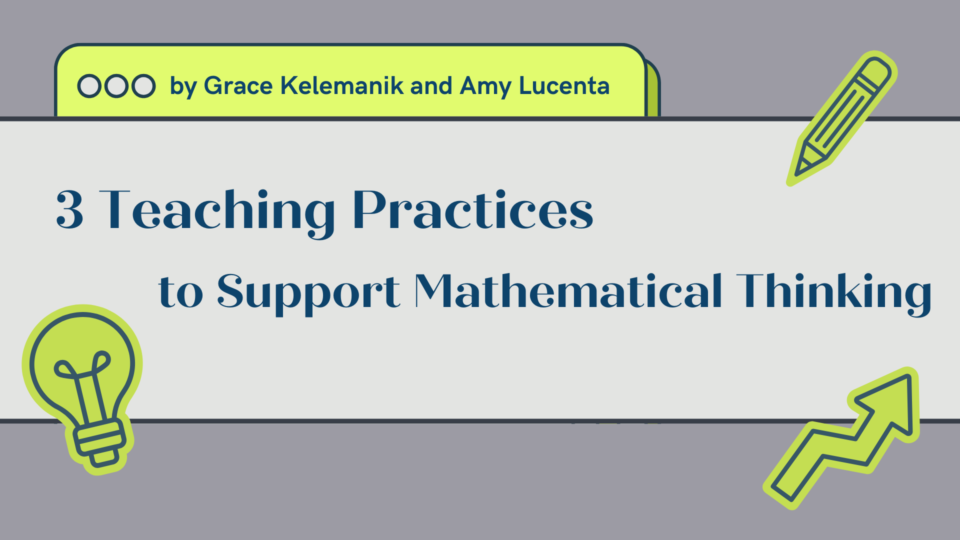
If teaching thinking requires specific student learning experiences, it would follow that it also requires certain teaching practices. The challenge in shifting to such practices does not lie in their complexity, but rather in the fact that they fly in the face of many of our current teaching habits that have been honed five periods a day, 180 days a year for years. They are second nature; we do them without even thinking. They include large grain-size routines like “I do, we do, you do,” and small moves like repeating what a student says when it is important or correct.
These teaching practices are not inherently bad; they are simply ineffective tools for the job of developing math thinking and reasoning. Having students check their answers with a partner makes a lot of sense if the goal is for students to accurately execute a procedure. But if the goal is thinking and reasoning, shifting the focus away from the answer and toward the initial sense making of the problem is the way to go. Asking individual students questions during whole-class discussions is an effective move if you are assessing recall of previously learned information, but if the question requires students to chew on an idea, a turn-and-talk is a better move.
Developing teaching practices that support math thinking and reasoning will require us to make three critical shifts in our instruction:
- Focus on thinking
- Step out of the middle
- Support productive struggle
- Focus on the Thinking. We need to spend more class time focusing on the thinking instead of the answers if our students are to become powerful math thinkers. We are not saying that arriving at a correct answer is not important; rather, we are saying that spending copious amounts of class time sharing answers and walking through calculations step by step will not help students learn to think and reason. To develop math thinking, we need to focus attention and classroom conversation where the thinking lives; namely, in what you pay attention to, the questions you ask yourself, and the subsequent actions you take.
- Step Out of the Middle. Teaching mathematical thinking requires us to step out of the middle and orient students to each other, so they can consider and collaborate around their mathematical ideas. Stepping out of the middle shifts the mathematical authority in the room. Instead of the teacher being the conduit of all math knowledge, students take on the responsibility of co-constructing their math understandings. Practically speaking, it means transforming teacher–student interactions into student–student interactions. When the teacher steps out of the middle, students work together to make sense of mathematics, solve problems, and convince themselves of the correctness of their work. When these collaborative work structures are set, the teacher’s role shifts and they listen in on student conversations, select and sequence ideas to bring to the full group, and pose questions for students to chew on together. In this way new roles form—students become increasingly responsible for the mathematical thinking and teachers become increasingly responsive to their students’ mathematical thinking.
Stepping out of the middle of students’ math doing requires actively positioning students to attend to, take up, and work with each other’s ideas. So, when teachers pose questions in a thinking classroom, instead of asking individual students to respond, they often prompt a turn-and-talk so that all students have a chance to think about the question as well as work though the language they will use in response. Rather than further explain a student connection, Mr. Ryan posed a question about that connection and prompted students to turn and talk to dig deeper into it. He then proceeded to tour the room, listening to get a sense of the range of student thinking, and avoided getting caught in a series of teacher–student interactions or conferring with each partnership. - Support Productive Struggle. Helping our students develop into powerful math thinkers means fighting the impulse to step in and rescue them as soon as they start to struggle. It means sending the message to students that mathematical thinking takes time and multiple passes to develop. Rather than providing hints and suggesting strategies so that students know the correct set of calculations to perform to get the answer, we must instead get in the habit of providing processing time and structures students can leverage to keep thinking productively about the task at hand. Our motivation to jump in quickly and lessen student struggle is well intentioned when we want to keep students from disengaging or getting frustrated or to ensure their problem-solving experience is a positive one. However, every time we do, we rob students of the opportunity to think and reason, and we send another subtle message that they are not capable of doing math themselves. Getting stuck is part of the thinking process and a necessary condition for developing perseverance.
Supporting productive struggle often means providing a variety of structures through which students can process ideas and thinking. Some examples of this are providing individual think time to prepare students to work with a partner or time to process an idea with a partner before sharing in the full group. Regularly asking students to rephrase classmates’ ideas during full-group discussions provides struggling students multiple opportunities to hear and process the ideas the class is developing.



